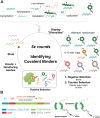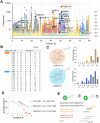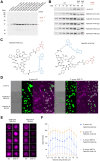This is a preprint.
An mRNA Display Approach for Covalent Targeting of a Staphylococcus aureus Virulence Factor
- PMID: 39574702
- PMCID: PMC11581011
- DOI: 10.1101/2024.11.06.622387
An mRNA Display Approach for Covalent Targeting of a Staphylococcus aureus Virulence Factor
Update in
-
An mRNA Display Approach for Covalent Targeting of a Staphylococcus aureus Virulence Factor.J Am Chem Soc. 2025 Mar 12;147(10):8312-8325. doi: 10.1021/jacs.4c15713. Epub 2025 Feb 27. J Am Chem Soc. 2025. PMID: 40013487
Abstract
Staphylococcus aureus (S. aureus) is an opportunistic human pathogen that causes over one million deaths around the world each year. We recently identified a family of serine hydrolases termed fluorophosphonate binding hydrolases (Fphs) that play important roles in lipid metabolism and colonization of a host. Because many of these enzymes are only expressed in Staphylococcus bacteria, they are valuable targets for diagnostics and therapeutics. Here we developed and screened highly diverse cyclic peptide libraries using mRNA display with a genetically encoded oxadiazolone (Ox) electrophile that was previously shown to potently and covalently inhibit multiple Fph enzymes. By performing multiple rounds of counter selections with WT and catalytic dead FphB, we were able to tune the selectivity of the resulting selected cyclic peptides containing the Ox residue towards the desired target. From our mRNA display hits, we developed potent and selective fluorescent probes that label the active site of FphB at single digit nanomolar concentrations in live S. aureus bacteria. Taken together, this work demonstrates the potential of using direct genetically encoded electrophiles for mRNA display of covalent binding ligands and identifies potent new probes for FphB that have the potential to be used for diagnostic and therapeutic applications.
Figures






Similar articles
-
An mRNA Display Approach for Covalent Targeting of a Staphylococcus aureus Virulence Factor.J Am Chem Soc. 2025 Mar 12;147(10):8312-8325. doi: 10.1021/jacs.4c15713. Epub 2025 Feb 27. J Am Chem Soc. 2025. PMID: 40013487
-
Covalent-fragment screening identifies selective inhibitors of multiple Staphylococcus aureus serine hydrolases important for growth and biofilm formation.Res Sq [Preprint]. 2024 Dec 13:rs.3.rs-5494070. doi: 10.21203/rs.3.rs-5494070/v1. Res Sq. 2024. Update in: Nat Commun. 2025 May 30;16(1):5046. doi: 10.1038/s41467-025-60367-3. PMID: 39711551 Free PMC article. Updated. Preprint.
-
Structural Basis for the Inhibitor and Substrate Specificity of the Unique Fph Serine Hydrolases of Staphylococcus aureus.ACS Infect Dis. 2020 Oct 9;6(10):2771-2782. doi: 10.1021/acsinfecdis.0c00503. Epub 2020 Sep 15. ACS Infect Dis. 2020. PMID: 32865965
-
Strategies for Tuning the Selectivity of Chemical Probes that Target Serine Hydrolases.Cell Chem Biol. 2020 Aug 20;27(8):937-952. doi: 10.1016/j.chembiol.2020.07.008. Epub 2020 Jul 28. Cell Chem Biol. 2020. PMID: 32726586 Free PMC article. Review.
-
Interaction of host and Staphylococcus aureus protease-system regulates virulence and pathogenicity.Med Microbiol Immunol. 2019 Oct;208(5):585-607. doi: 10.1007/s00430-018-0573-y. Epub 2018 Nov 27. Med Microbiol Immunol. 2019. PMID: 30483863 Review.
References
-
- Schwartz P. A.; Kuzmic P.; Solowiej J.; Bergqvist S.; Bolanos B.; Almaden C.; Nagata A.; Ryan K.; Feng J.; Dalvie D.; Kath J. C.; Xu M.; Wani R.; Murray B. W. Covalent EGFR Inhibitor Analysis Reveals Importance of Reversible Interactions to Potency and Mechanisms of Drug Resistance. Proceedings of the National Academy of Sciences 2014, 111 (1), 173–178. 10.1073/pnas.1313733111. - DOI - PMC - PubMed
Publication types
Grants and funding
LinkOut - more resources
Full Text Sources
